|
Ancient
North & Central American History of the Wild Turkey
 |
|
15th
Century Aztec Drawing of a Wild Turkey
|
There are two types of
wild turkey, both of which are strong fliers (up to
55 mph for short distances) and among the fastest
runners (15-30 mph). One type is originally from Yucatan
and Guatemala (Agriocharis ocellata; family - Phasianidae)
and the other is from Mexico and the US (Meleagris
gallopavo; family -Phasianidae). Fossil records have
shown they were once much more widespread. They diverged
from pheasants 11 million years ago and were likely
distributed continuously from middle latitudes of
North America to northern South America during the
Pleistocene.
Turkey (Meleagris gallopavo), or "huexolotlin"
in the ancient language of the Aztecs in Mexico was
one of the first animals in the Americas to be domesticated.
The Aztecs in Mexico considered "huexolotlin"
so important, they dedicated two religious festivals
a year to the birds. During the celebration, turkey
eggshells which had been saved for months were strewn
upon the streets to honor the god who favored them
with such a plentiful source of food. The turkey was
also one of the manifestations of Tezcatlipoca, the
trickster god, who had been elevated to the highest
position in the Aztec polytheistic pantheon. All year
round, it was not uncommon for over 1000 turkeys a
day to be sold in a busy Aztec market. There is evidence
that turkeys and were kept in pens for their plumage.
The natives used turkey feathers for necklaces, head
adornments, and arrows.
Appreciation for the turkey was also
evident in the Mayan culture where parts of the bird
were used in sacred ceremonies. Its popularity among
other tribes grew, and the turkey population had spread
far beyond Mexico by the time the first European explorers
set foot there.
In North America, tribes like the
Navajo first encountered wild turkeys after they had
trouble keeping the hungry birds away from the scanty
crops they had scratched out of the desert. Losing
the battle to bar them from the cornfields, they decided
instead to feed the turkeys and fence them in. By
barging in and refusing to leave, the invading turkeys
unwittingly provided a controlled source of protein
and ornamental feathers. Instead of pests, they became
symbols of friendship and providence.
The Eastern turkey subspecies, Meleagris
gallopavo silvestris, spread to the Northeast where
nomadic Indians did not bother to domesticate the
bird who enjoyed the abundant vegetation and thrived
without agricultural welfare. Tribes like the Wampanoags
hunted wild turkeys with bows and arrows. The turkeys
were "called up" by imitating their calls,
and then grabbed by a child hiding behind some logs
or in a pit, or shot with bow and arrow.
Some say Christopher Columbus named
turkeys "tuka," the Tamil word for peacock.
Considering Columbus thought he was in India at the
time of the alleged naming, not in the New World where
he actually was, this definition seems fairly plausible.
Another suggestion is that Luis de Torres, a physician
who served under Columbus, named the bird "tukki,"
which translates to "big bird" in Hebrew.
Some say the North American Indians called the bird
"firkee." If so, it's a word everyone else
has mispronounced the past 508 years.
In 1519, Cortez and his fellow Spanish
Conquistadors had found the Aztecs raising huexolotlin
around their homes. The Aztec emperor, Montezuma,
kept the turkeys in his famous zoo, it is said, as
food for the other animals. Cortez might have been
served turkey mole poblano (mole of the people.) Turkey
mole poblano is traditionally prepared with chocolate
and chile.
The Spaniards soon carried the savored
"el pavo" back to Europe where they quickly
became a popular fowl and a choice dish for state
dinners. The turkey was little larger than the traditional
goose, with a lot more meat and a refreshingly new
taste. These exotic birds were introduced at a time
when America was called The Spanish Indies or the
New Indies, illustrating the confusion in people's
minds about the true location of this new land that
Columbus had found. As a result, the Spaniards mistakenly
called them "Indian fowl." As the Indian
fowl was eventually acquired and raised throughout
Europe and Asia, many languages, as well as others
like Arabic and Hebrew, called the "Indian fowl"
names like the "bird of India."
In 1530, English merchants trading
out of that area of the eastern Mediterranean called
the Levant but whom the English called "Turkey
merchants" because that whole area was then part
of the Turkish empire. The "Indian fowl"
was served to and enjoyed by all. The English mistakenly
named this fowl a "Turkey bird", or "Turkey
cock". To compound the difficulties the English
had with this immigrant fowl, at about the same time,
the 1530s, Portuguese merchants reintroduced the guinea-fowl
from West Africa, which had last been seen in England
at the time of the Romans. As it was the same Levant
merchants who brought this into the country, the guinea
fowl was also known for a time as the "Turkey
bird", though this confusion didn't last long.
For example, the heraldic arms granted to William
Strickland in 1550 featured "a turkey-bird in
his pride proper" and the bird shown is quite
definitely a proper turkey.
Next
Page >>
|

